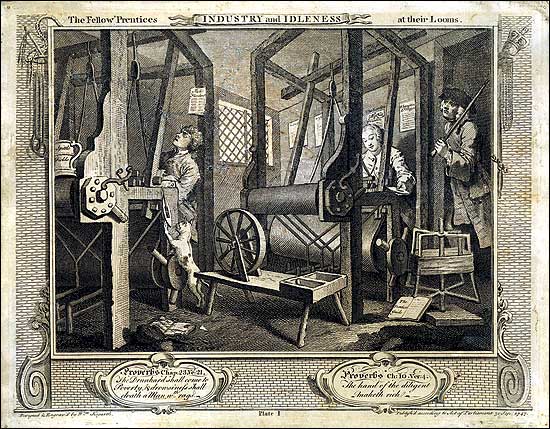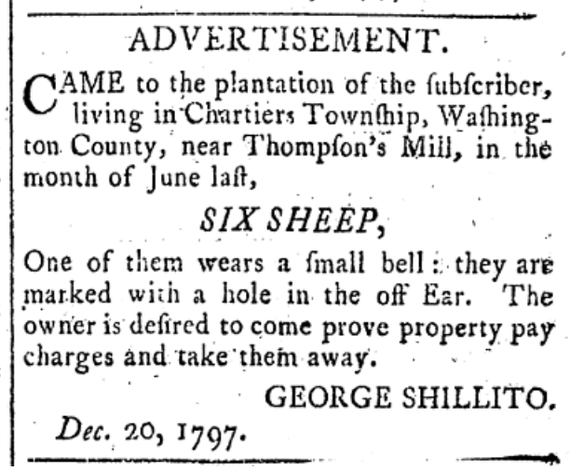|
A Shillito cousin recently contacted me, curious about my sources for George Shillito, a weaver who immigrated to Pennsylvania with his family in 1773. It was a tricky discussion because this cousin and others have extensively researched the family and I'm making conclusions that appear to come out of nowhere; specifically, my contention that my 4x great-grandfather, Edward Shillito, is the son of George Shillito. Kay Johnston wrote an extensively researched book about the Shillito family. While I don't have her manuscript, I'm told that there is no mention of my Edward Shillito in her book as a son of George. Samuel Smith also wrote a book about the Shillito family in 1931 and, again, there is no mention of Edward Shillito, although many other Shillitos researched by Johnston are also absent from his book, which is more narrowly focused on the genealogy of only one of George's sons. I'm told that Johnston claims George Shillito was born about 1740 in Scotland and then was taken to Ireland about 1745/48. This is consistent with Smith, who gives the same dates and claims that the move was motivated by a Scottish revolt against the Church of England. I'm not certain of the source of these claims; it could be a written family record or simply an oral family history. I'm also not certain as to the accuracy. Shillito is an unrecorded name in Scotland at this time but an almost common name in Yorkshire, England. However, whether the Shillitos made a brief detour through Scotland or went directly to Ireland, it's not unlikely they joined into the Scots-Irish culture. Smith further claims that George, a weaver, migrated to Germantown, Pennsylvania in 1773 with three sons: George, Samuel and an unnamed 3rd brother, whom may have returned to Ireland. However, while Johnston agrees with the profession and the migration to Germantown, she claims that George had the following children: George, Thomas, William, John, Samuel and 5 daughters. Lacking sources, I have to look at what records I have available to determine if I can prove or disprove these claims. I also need to determine how my Edward Shillito fits into the mix. Regarding Edward Shillito: according to the 1810 U.S. Census, he was age 45 or older, placing his birth year as 1765 or earlier. According to the 1830 U.S. Census, Edward was age 60 to 70 years old, placing his birth year between 1760 and 1770. On the 1880 U.S. Census, his daughter, Alice, identifies his birthplace as Ireland. If this information is correct, it would put his birth year between 1760 and 1765 in Ireland. According to numerous records, Edward was a millwright and mill builder, often in remote areas on the American frontier. The earliest record I can find for a George Shillito in America is on a 1781 Pennsylvania tax record for Hamilton township in Cumberland County. George Shalatoe owned 1 cow rated at $200. He appears again on a 1786 tax record for Franklin County with no tax payment amount next to his name and in numerous tax assessments and censuses afterwards, with the last being in 1814, which provides his profession as a weaver, confirming his profession. In the January 21st, 1784 issue of the Pennsylvania Gazette, there is a mention of Edward Shillito, who has a letter remaining at the Philadelphia Post-Office. If his is my Edward, he would be between 19 and 24 and not living with George. If he had been an apprentice millwright, however, he would have been apprentice out about 14, so between 1774 and 1779 and a full 7-year apprenticeship would have been completed between 1781 and 1786. If Edward were a typical apprentice and still apprenticed in 1784, his birth year would be between 1763 and 1765, consistent with later census information. On the 1787 tax list for Southampton Township in Franklin County, we have two sets of state tax payments, which name 3 Shillito men: George Shillitoe paid 12 shillings, 6 pence and 10 shillings Edward Shillito paid 1 shilling, 11 pence and 2 shillings, 4 pence Thomas Shillitoe paid 12 shillings, 6 pence and no 2nd record tax payment Assuming this is my Edward, he would between 22 and 27 and completed his apprenticeship. It would also explain his low taxes, since he would just be starting out with his trade. Of course, Pennsylvania also had a profession tax so it just might be that millwrights paid less tax than weavers. On the 1790 U.S. Census, which enumerated only heads-of-household, we find more Shillito men in Franklin County: George Shelleto, Franklin County, PA; Household: 2 males over 16, 1 male under 16, 3 females Edward Shellito; Household: 2 males over 16, 1 male under 16, 1 female Wm. Shelleto; Household: 1 male over 16, 1 female This census entry for Edward is interesting. If it is my Edward then who are the other members of the household. His wife, Sarah, informed the 1850 census takers that she was 70 years old, meaning she was too young to be married in 1790. Could Edward have been previously married? Are these other family members? Could this be a different Edward? It seems unlikely as there are a limited number of Shillito men in the state at this time, until a new group arrives in 1811, According to Johnston, George had 5 sons: George, Thomas, William, Samuel, and John and there are many records of them in Pennsylvania:
John's claim he was born in Pennsylvania in 1774 supports Smith's contention that George Shillito arrived in 1773. However, if Johnston is correct and all this men are the sons of George, it invalidates Smith's claim that there were only three brothers. If Johnston is basing her claim that George had these 5 sons based on records, I'm still not certain why why excluded Edward. As we see, though, all these men have many facts in common with my 4x-great-grandfather Edward:
Given the factors above and that Shillito is a relatively uncommon name, it is not clear why Johnston included 5 of these men as sons of George but excluded Edward. It may be that her research was based as much on oral history as the documentary evidence. So why would an oral history exclude Edward if he was the son of George? There is also the possibility that she had documentation, such as a family bible, that I lack. After Franklin County, 3 of these brothers moved west to the adjoining Washington, Allegheny, and Beaver Counties while Samuel and John died in Franklin County, where their father lived to 1817. On the other hand, Edward moved north to Lycoming County and then further north to New York State, where he worked building and operating sawmills. It may simply be that Edward removed himself too far out of the area soon after 1790 and much of the family lost touch with him. This map above shows the dispersion of the family. 1. George Shillito Sr. arrives in Germantown near Philadelphia in 1773. Edward Shillito receives a letters in Philadelphia in 1884. 2. George Shillito Sr. recorded on a tax list in Hamilton Township, Cumberland County in 1781. 3. George Sr, Edward, William Thomas, John and Samuel recorded on tax lists and censuses in Franklin County from 1786 to 1800. George Sr, Samuel, and John appear to remain in Franklin County until their deaths in 1817, 1815, and after 1850, respectively. William remains in Franklin County past 1820, when he then moves west to Ohio, before moving to Allegheny County after 1830. 4. Edward works as a millwright at Pine Creek, Lycoming County in 1800 5. George Jr resides in Washington County from 1797 and 1810 6. Edward moved to New York State to build and operate sawmills 7. Thomas moves to Pitt, Allegheny County in 1810, where he lives past 1830. George Jr. moves to Allegheny County after 1810. William moves to Allegheny County after 1830. 8, George Jr. moves north and west to Beaver County after 1810. 9. A new wave of Shellitos arrive from Ireland to Crawford County after 1800, perhaps in 1811. One of these Shellitos is named Edward and fought in the War of 1812. Many family researchers confuse this Edward with the Edward who lived in Franklin County in 1790 but these are two different men. Of course, another answer is that Edward is simply not the son of George Shillito. However, DNA evidence shows that Edward was certainly related to all the Shillitos of Pennsylvania, including the group that arrived after 1800. However, while the decedents of Edward are related to descendants of both the 1763 and 1811 groups, they are very likely more closely related to the former based on the number of centimorgans shared with the various descendants.
Still, DNA is a funny thing and Edward might be a nephew, much younger brother, or cousin of George Shillito Sr. However, given that he appears in both Philadelphia and Franklin County with the other Shillito family members, is of the same age as the other supposed Shillito sons, and the DNA evidence, it would seem unnecessarily complicated to suppose he was anything but the son of George Shillito Sr. At least until some negative evidence is provided. Comments are closed.
|
Archives
2023 JAN FEB MAR APR MAY JUN JUL AUG SEP 2022 JAN FEB MAR APR MAY JUN JUL AUG SEP OCT NOV DEC 2021 JAN FEB MAR APR MAY JUN JUL AUG SEP OCT NOV DEC 2020 JAN FEB MAR APR MAY JUN JUL AUG SEP OCT NOV DEC 2019 JAN FEB MAR APR MAY JUN JUL AUG SEP OCT NOV DEC 2018 JAN FEB MAR APR MAY JUN JUL AUG SEP OCT NOV DEC 2017 JAN FEB MAR APR MAY JUN JUL AUG SEP OCT NOV DEC 2016 JAN FEB MAR APR MAY JUN JUL AUG SEP OCT NOV DEC 2015 JAN FEB MAR APR MAY JUN JUL AUG SEP OCT NOV DEC 2014 OCT NOV DEC Categories |




 RSS Feed
RSS Feed